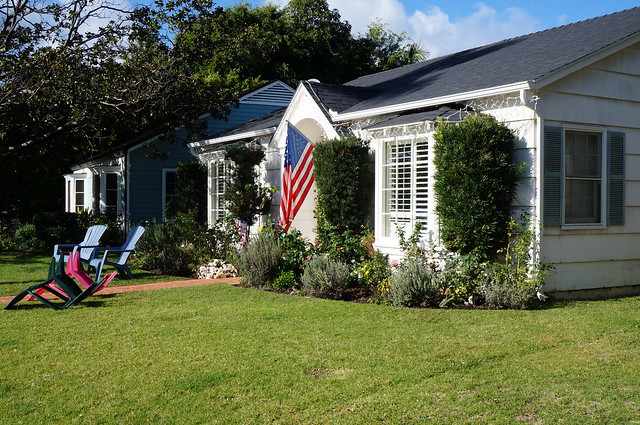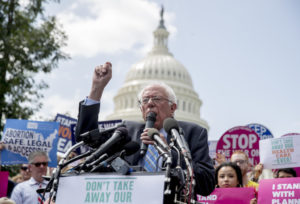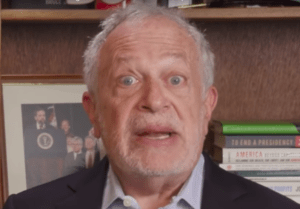What’s Behind America’s Racial Wealth Gap?
"The Color of Money" author Mehrsa Baradaran examines the long-term ramifications of denying African Americans home and property ownership. Leandro Neumann Ciuffo / Flickr
Leandro Neumann Ciuffo / Flickr
What follows is a conversation between author Mehrsa Baradaran and Jacqueline Luqman of The Real News Network. Read a transcript of their conversation below or watch the video at the bottom of the post.
JACQUELINE LUQMAN: This is Jacqueline Luqman with The Real News Network.
The racial wealth gap is finally being discussed seriously in this election cycle and in the country. And some people are even citing the history of slavery, racism, and discrimination that created the racial wealth gap. One of the key factors in the creation of this phenomenon of the racial wealth gap is housing policy. Or more specifically, there is a link between the ability white people have historically had to own property and homes that have accumulated value and created wealth, that they were able to pass down to future generations, that black people were not allowed to enjoy equally.
Joining me to talk more about this issue, some of the policies that created it, and potential policies that could finally tackle it, is Professor Mehrsa Baradaran. Professor Baradaran is a Professor of Law at UC-Irvine Law School, and the author of The Color of Money and How the Other Half Banks. Professor Baradaran, thank you so much for joining me today.
MEHRSA BARADARAN: Thank you so much for having me. I love your network and I’m always happy to talk to you.
JACQUELINE LUQMAN: Well, let’s dig into this topic because there is so much, and I want to connect as many dots as we possibly can.
MEHRSA BARADARAN: Sure.
JACQUELINE LUQMAN: I want to start with, why should we focus on policies that address the racial wealth gap specifically, and not just the general economic inequality that all Americans are concerned about? Because the areas that are being discussed as economically distressed, are economically distressed for specific reasons, so could you explain that a little bit?
MEHRSA BARADARAN: Yeah. I mean, this whole class versus race debate I feel like is this boogeyman that people say, “Well, why isn’t it everybody?” And I think we have a race-based class system in the US. And so, every time you want to talk about the racial wealth gap, you get a cohort of people saying, “Well, isn’t it just class?” And by the way, it’s the same cohort of people that doesn’t want to talk about class, ever. So I mean, those arguments for me I think are just a way to shut down this conversation. But why talk about specifically the black-white racial wealth gap, and not generally poverty, or generally racism, and things like that? And the reason is because we have had an economic system, a housing system, a school system, a credit system, that has specifically excluded black populations through housing, through student loans, through credit, through businesses, from the wealth accumulation of whites. And whiteness has been defined differently throughout time. And so we can go through the history of whiteness, but all of it has been built on an anti-blackness.
And so, I think we need to talk about the racial wealth gap if we’re going to understand any of the sort of anti-poverty movements in this country. We have to talk about the racial wealth gap if we’re going to talk about housing, or schools, or anything like that. You can’t understand why we have the gaps that we do and the inequalities that we do until you understand it was all based on anti-black racism and segregation. And this racial wealth gap was created purposefully. It was maintained over time through policies that were federal, state and local. And it is still ongoing, and it still self-perpetuates now without added inputs.
And I also want to be clear that, though I talk a lot about fixing the racial wealth gap through housing and through a variety of different policies, I think what is the most important policy thing that we can do is to talk about reparations in a serious methodological way. Just to measure the harms done, to look at the theories of justice that would justify a solid and robust reparations program, and just start to go down that road. But there’s a lot that could be done also just focusing on housing before we get there.
JACQUELINE LUQMAN: And you bring up a good point because you bring up the discussion of reparations and the need to methodically study the harm done, the impact of the harm done, and the lasting legacy of the harm done, which incidentally or not incidentally, is what the House bill H.R. 40 does. That has always been the focus of H.R. 40. People mistake it as a piece of legislation that’s literally going to cut a check for black people. But no, it is literally to do exactly what you just said: to embark upon the methodical, scientific, historical, data-driven study of not just slavery, but the impacts of Jim Crow, segregation, redlining, all those other things. So that’s a great aside that I’m so glad you brought up.
MEHRSA BARADARAN: Absolutely. And I think when you talk about reparations to people, I mean, I think they want to immediately go to, “How does it work?” But I see that as step four or five or six, right? Step one is we need to just catalog the ways in which wealth was extracted, that wealth was deprived for these communities, that there was exploitation and exclusion. Measure that, measure the benefits to those who excluded and exploited, and then measure the harm. So that’s step one and two.
Step three is to look at, what are the possible theories of justice? I mean, I teach contracts. I teach contracts damages, and there’s a variety of ways that we talk about justice. You can compensate people if you breach a contract, which the US government has breached its contract to the black population over, and over, and over again, right? They did it with the Native American treaties also, but they have done it with black populations without recognition that they had any duties and that they were violated. So what does that breach entail? How do you make it right? How do you make a remedy? So when we talk about contracts, we talk about, okay, do you compensate for the wrongs? Do you make them whole? What does that look like? Do you look at unjust enrichment? What did you gain unjustly through slavery, through Jim Crow, through segregation? How do you measure that?
We talk about all of these other aspects and theories of justice. Just apply that here and say, “What does that look like to make people whole for slavery, for Jim Crow, for segregation? And how do we do that?” And we know how to do this stuff. It’s not rocket science and it’s not totally out of the realm of possibility. I mean, you see—Recently I was at the DOJ. And Wells Fargo, when it gets by violations for racial discrimination, the DOJ comes down hard on them, takes a fee of about $7 billion or something like that, and they put it in a pot to be used in the community to give down payments. So this is, it’s not exactly like, “You harmed a certain set of people through racially discriminatory policies, and your remedy is going to be to create a fund of some sort to pay back different people, but within that same community.”
And so we do this stuff all the time in law. And a lot of times in this reparations context, you see people just holding up barriers like, “Oh, we can’t do that. The people aren’t alive,” blah, blah, blah. And that’s fine. It’s never been a barrier before. So that’s just reparations. Back to racial wealth gap policy, I think you can look at the ways in which the racial wealth gap currently self-perpetuates, so this is in disparate housing, disparate schooling, disparate credit, and to remedy those different segments of the credit-banking sort of economy, and sort of lower the gaps.
JACQUELINE LUQMAN: So specifically focusing on housing in this conversation because it has been argued by several experts. I think Forbes Magazine has pointed this out. Certainly the study that was published last year by Duke University that recognized that housing is a significant, or the disparity in housing is a significant contributor to the racial wealth gap because of the way certain groups of people were able to benefit from owning land and housing, and other groups of people were not.
And as you said, compensating people for harm done has been something that has been done and continues to be done when, in the example you used, when Wells Fargo discriminates against people and the federal government goes after them and extracts a fine from them. Recently, have there been efforts— and by recently, I do mean in the past 40 years— have there been policy efforts to address, even on the surface, the legacy of this unequal housing policy? And have they worked and why haven’t they?
MEHRSA BARADARAN: There has not. There has not been a single active policy to remedy the disparate housing policies. There have been policies like the Fair Housing Act that was passed in 1968 to prohibit discrimination against African Americans or other minorities. And those are fine, but that’s about sort of pegging violations and saying … That’s where the DOJ actions come in. It’s about enforcement, so stop discriminating. However, as you know, you can have disparate impact on housing. So you can create zoning restrictions. You can suck wealth out of communities. You can segregate as long as you’re not doing it racially, but you’re doing it because of—Places where you put certain public housing, or where you don’t allow certain building spaces in certain communities, then that doesn’t count, right?
So I think, going back to the original sort of 1968 debate over fair housing, everyone understood that it was either about—You have this, starting in the 1930s, as you know about redlining, right, and you have just the two different housing sectors. One is tenants. You’re paying rent. You’re living in an apartment. It’s segregated. It’s cramped. You’re just kind of being put in this place. You’re not getting a mortgage. You’re not getting credit. In the white suburbs, you’re building wealth, you’re getting credit, all of that stuff. Those things were incredibly consequential. What we’ve never done is say, “Okay, we did this race-based housing market, now let’s fix it.”
How do you do that? You either put capital into the segregated black spaces, so that’s a reparations program. There’s a couple – like CORE, the Congress of Racial Equality, in 1968 passed a bill that would create a World Bank-type thing within the black spaces that would just be capitalized by Treasury and just put money back in, right? So this was a reparations-style thing that almost got passed. But then Nixon obviously puts that stuff away. The other is integration. In MLK’s coalition, people like George Romney and Robert Kennedy actually coming up with integration programs, and this would be actually giving people homes wherever they want it, right? Or building nice places within integrated spaces. And that got shut down quickly by Richard Nixon, who understands that he is elected to stop integration, to stop school integration and housing integration.
And so what we have today is a housing policy where white families pay to live in all-white spaces and have all-white schools. I mean, we essentially have – everything comes down to housing in this country, class specifically. And educational access and social capital and all of that stuff, it’s whether you can buy a million-dollar house in some suburb in DC and send your kids to the best schools in the country. And if you can’t, you’re sort of on this different track, and your house is not going to gain in value. The schools are not going to be as well-funded because the funding comes from local taxes. You’re not going to have the social capital because the businesses don’t have enough capital to thrive. So all of that I think, it’s not just housing, but housing is a root cause and it’s all interrelated. Yeah.
JACQUELINE LUQMAN: So you brought up Richard Nixon and he’s an important, I think, figure in this conversation because an initiative that may have begun with him, continues to be perpetrated. Allegedly, to address this issue of housing inequality at least, or at least resolving the issue of economically depressed neighborhoods, right? So Nixon introduced this thing called “opportunity zones” in opposition to the proposals for economic redress for people centered around housing. He introduced this idea of opportunity zones, where basically investment, private investors would be given tax breaks to invest in these economically depressed neighborhoods. And this has been perpetuated ever since Nixon. As a matter of fact, the Trump administration has a new policy that’s centered around opportunity zones. Does this work? Does this work to address this, especially racial inequality in the housing market?
MEHRSA BARADARAN: No. And let me clarify, because I wrote – I mean, my book is centered around this, Nixon’s idea, and he was not the first person that called it “opportunity zones.” He called it “black capitalism.”
JACQUELINE LUQMAN: Ah.
MEHRSA BARADARAN: And the idea is this. You’ve got reparations, one group, so the Black Power groups that were demanding reparations, and you’ve got another coalition demanding integration. And instead, he sort of goes the middle or nothing. He’s not going to give anything. And what it is, is, “I will co-opt the language of the Black Power movement asking for black power.” And what they meant by black power is sovereignty within the black spaces, capital, and redress, right? But what Nixon meant is, “We’re going to maintain the segregated economy and the segregated housing system, and we’re going to do this thing where we try to coax private entities to come in and build businesses and make loans and stuff in that community.” So then it morphs into enterprise zones in the Reagan era. He calls it “enterprise zones.” And then Clinton actually doubles down on this also, he calls it “enterprise zones.” It used to be called “the black ghetto” because it was understood that it was forced segregation. And over time, that term gets whitewashed and it becomes an entrepreneurship zone, an enterprise zone, and an opportunity zone.
And so this opportunity zone program of Trump’s leads directly back to Nixon. And what it was, was a decoy from actual policy. It’s not capital, and it’s not integration. It’s not real. It is just a way to give tax incentives and sort of goodies to private equity firms to come in and build in those spaces. The community does not get the equity. So the best-case scenario is gentrification and displacement, right? So [crosstalk]
JACQUELINE LUQMAN: That’s the best-case scenario?
MEHRSA BARADARAN: The best-case scenario is that a community gets revitalized, right? That’s the point. And what does that mean? A Whole Foods comes in, Starbucks comes in, all of that stuff. There’s no effort to pass that equity onto the people, right? The people who live there. So the best-case scenario with revitalization is what happens in Harlem or in Brooklyn. I’m from New York, so we’ve seen this happen. And the tenants, who don’t own the land, get displaced. And the people that gain the equity are the first comers, right? The sort of – we call them yuppies, professionals. The people who can come in and buy, and then turn over and sell.
JACQUELINE LUQMAN: Wow. So the best-case scenario in regard to these kinds of investment in distressed communities isn’t a best-case scenario for the people who live there. It’s a best-case scenario for the investors. So, all right. This is – we don’t have a lot of time left, but I need to ask you about your proposal, which is called the 21st Century Homestead Act. I want to ask you about why the proposal will work differently from this idea of opportunity zones, and economic zones, and private investment that we just talked about. But could you go into, really quickly, the reason the title is important? Because, historically, it absolutely is.
MEHRSA BARADARAN: Yeah. So I want to make sure, I mean, the Homestead Act was hugely problematic in a lot of ways. One is that it kicked Native Americans off their land, it was environmentally not great, and it excluded black families. But I’m using this because it did build white wealth, and I want to do it right this time, right? So I think hearkening back to this era of white affirmative action and policies that give white people land and money, right, the Homestead Act and the FHA are two, to do them differently this time. I think that’s why it’s important to use those terms to say, when people say, “This is crazy.” And the response is, “Well, we did this before. We just did it for the – we did it for white people and not everyone else.”
So the idea of the Homestead Act is to revitalize communities, but to give the land to the residents of the communities first. So Baltimore did try to do a Dollar Homes program a while back. The problem was that the banks wouldn’t lend for improvements because the property values were so low, and they couldn’t get the appraisals to come in at anywhere near the price. And so, my Homestead Act, you would get the land for free and you would get improvements, all provided by a grant administered by the federal government and the city itself.
And so the qualifying individuals would be anyone who’s lived in a redlined community for the past five to 10 years, a formerly redlined segregated community. They’ve got a bunch of different restrictions. We’re trying to get at not just the people in that area who have lived there. So we’re not trying to target investors, no gentrifiers. It’s just the locals who live there. You get a home, you get an improved home, and you’re paying less than you would in rent, and you get to own the home as it sort of increases in value. And you get to have that equity as the place revitalizes.
So along with the home, there’s also a jobs programs. I mean, akin to the New Deal, akin to the FHA, you can’t just give people a home and say, “Okay, just pay for it.” There’s also got to be a jobs program that comes along with it. So what do you do? So I’ve got a variety of different ways that cities can create jobs. And the easiest way would be to do what the government already does— a lot of VA hospitals and Energy Department loans and things like that. And the idea would be to couple one of those projects or facilities with an area that needs this revitalization. So whether it’s Baltimore or Detroit, Dayton, Ohio, anywhere that is a formerly segregated space that still has retained a largely black population, as opposed to places that were segregated and are now gentrified, right? So places in St. Louis where it used to be a black population and now it’s all gentrified. So you would actually go to, let’s say Ferguson as opposed to inner city St. Louis, and within Ferguson. That’s where you would do the handover of property.
JACQUELINE LUQMAN: This is really an amazing proposal, not because it’s groundbreaking because it really isn’t. Because as you said, Professor Baradaran, we’ve done this before. This country has done this before. It just wasn’t done for black people. It wasn’t done for Native people. And we are finally broaching the topic of doing this for people who were left out in the beginning. Of course, there’s so much more to get into about this topic, but we just scratched the surface today. And unfortunately, we don’t have any more time. But I would love to continue this topic not just on the urban/suburban focus that a lot of these proposals, whether they worked or not, have been geared toward, but also the impact of the same kind of racist policies that have had on black farmers, and how land value and the accumulation of wealth through land has also impacted black people in rural areas. But for now, Professor Baradaran, I thank you so much for coming on today and talking to me about this subject.
MEHRSA BARADARAN: Thank you so much for having me. And if anyone’s curious, there’s a lot more information in the book. It’s hard to talk fast and cover everything, but I kind of wrote it all down, and I hope that people find it useful.
JACQUELINE LUQMAN: I am absolutely sure they will. I did. I highly recommend Professor Baradaran’s work. I’m absolutely being very biased right now as a journalist, but I thank you all for watching. This is Jacqueline Luqman from Baltimore with The Real News Network.
Your support matters…Independent journalism is under threat and overshadowed by heavily funded mainstream media.
You can help level the playing field. Become a member.
Your tax-deductible contribution keeps us digging beneath the headlines to give you thought-provoking, investigative reporting and analysis that unearths what's really happening- without compromise.
Give today to support our courageous, independent journalists.





You need to be a supporter to comment.
There are currently no responses to this article.
Be the first to respond.